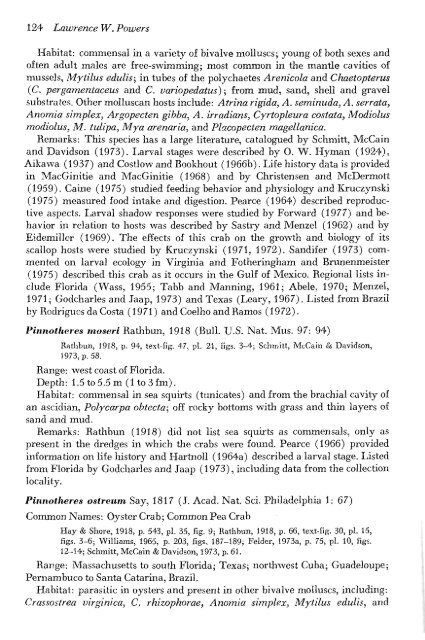You also want an ePaper? Increase the reach of your titles
YUMPU automatically turns print PDFs into web optimized ePapers that Google loves.
124 Lawrence W. Powers<br />
Habitat: commensal in a variety of bivalve molluscs; young of both sexes and<br />
often adult males are free-swimming; most common in the mantle cavities of<br />
mussels, Mytilus edulis; in tubes of the polychaetes Arenicola and Chaetopterus<br />
(C. pergamentaceus and C. variopedatus); from mud, sand, shell and gravel<br />
substrates. Other molluscan hosts include: Atrina rigida, A. seminuda, A. serrata,<br />
Anomia simplex, Argopecten gibba, A. irradians, Cyrtopleura costata. Modiolus<br />
modiolus, M. tulipa, Mya arenaria, and Placopecten magellanica.<br />
Remarks: This species has a large literature, catalogued by Schmitt, McCain<br />
and Davidson (1973). Larval stages were described by 0. W. Hyman (1924),<br />
Aikawa (1937) and Costlow and Bookhout (1966b). Life history data is provided<br />
in MacGinitie and MacGinitie (1968) and by Christensen and McDermott<br />
(1959). Caine (1975) studied feeding behavior and physiology and Kruczynski<br />
(1975) measured food intake and digestion. Pearce (1964) described reproductive<br />
aspects. Larval shadow responses were studied by Forward (1977) and behavior<br />
in relation to hosts was described by SasUy and Menzel (1962) and by<br />
Eidemiller (1969). The effects of this crab on the growth and biology of its<br />
scallop hosts were studied by Kruczynski (1971, 1972). Sandifer (1973) commented<br />
on larval ecology in Virginia and Fotheringham and Brunenmeister<br />
(1975) described this crab as it occurs in the Gulf of Mexico. Regional lists include<br />
Florida (Wass, 1955; Tabb and Manning, 1961; Abele, 1970; Menzel,<br />
1971; Godcharles and .laap, 1973) and Texas (Leary, 1967). Listed from Brazil<br />
by Rodrigues da Costa (1971) and Coelho and Ramos (1972).<br />
Pinnotheres inoseri Rathbun, 1918 (Bull. U.S. Nat. Mus. 97: 94)<br />
Rathbun, 1918, p. 94, text-fig. 47, pi. 21, figs. 3-4; Schmitt, McCain & Davidson,<br />
1973, p. 58.<br />
Range: west coast of Florida.<br />
Depth: 1.5to5.5m (lto3fm).<br />
Habitat: commensal in sea squirts (tunicates) and from the brachial cavity of<br />
an ascidian, Polycarpa obtecta; off rocky bottoms with grass and thin layers of<br />
sand and mud.<br />
Remarks: Rathbun (1918) did not list sea squirts as commensals, only as<br />
present in the dredges in which the crabs were found. Pearce (1966) provided<br />
information on life histoiy and Hartnoll (1964a) described a larval stage. Listed<br />
from Florida by Godcharles and Jaap (1973), including data from the collection<br />
locality.<br />
Pinnotheres ostreum Say, 1817 (J. Acad. Nat. Sci. Philadelphia 1: 67)<br />
Common Names: Oyster Crab; Common Pea Crab<br />
Hay & Shore, 1918, p. 543, pi. 35, fig. 9; Rathbun, 1918, p. 66, text-fig. 30, pi. 15,<br />
figs. 3-6; Williams, 1965, p. 203, figs.. 187-189; Felder, 1973a, p. 75, pi. 10, figs.<br />
12-14; Schmitt, McCain & Davidson, 1973, p. 61.<br />
Range: Massachusetts to south Florida; Texas; northwest Cuba; Guadeloupe;<br />
Pernambuco to Santa Catarina, Brazil.<br />
Habitat: parasitic in oysters and present in other bivalve molluscs, including:<br />
Crassostrea virginica, C. rhizophorae, Anomia simplex, Mytilus edulis, and

















